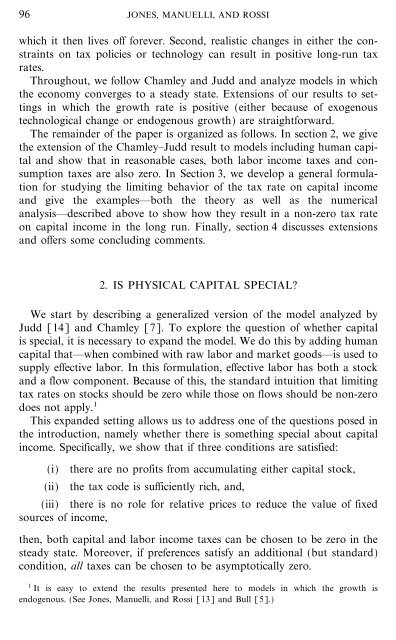On the Optimal Taxation of Capital Income
On the Optimal Taxation of Capital Income
On the Optimal Taxation of Capital Income
Create successful ePaper yourself
Turn your PDF publications into a flip-book with our unique Google optimized e-Paper software.
96 JONES, MANUELLI, AND ROSSI<br />
which it <strong>the</strong>n lives <strong>of</strong>f forever. Second, realistic changes in ei<strong>the</strong>r <strong>the</strong> constraints<br />
on tax policies or technology can result in positive long-run tax<br />
rates.<br />
Throughout, we follow Chamley and Judd and analyze models in which<br />
<strong>the</strong> economy converges to a steady state. Extensions <strong>of</strong> our results to settings<br />
in which <strong>the</strong> growth rate is positive (ei<strong>the</strong>r because <strong>of</strong> exogenous<br />
technological change or endogenous growth) are straightforward.<br />
The remainder <strong>of</strong> <strong>the</strong> paper is organized as follows. In section 2, we give<br />
<strong>the</strong> extension <strong>of</strong> <strong>the</strong> Chamley Judd result to models including human capital<br />
and show that in reasonable cases, both labor income taxes and consumption<br />
taxes are also zero. In Section 3, we develop a general formulation<br />
for studying <strong>the</strong> limiting behavior <strong>of</strong> <strong>the</strong> tax rate on capital income<br />
and give <strong>the</strong> examples both <strong>the</strong> <strong>the</strong>ory as well as <strong>the</strong> numerical<br />
analysis described above to show how <strong>the</strong>y result in a non-zero tax rate<br />
on capital income in <strong>the</strong> long run. Finally, section 4 discusses extensions<br />
and <strong>of</strong>fers some concluding comments.<br />
2. IS PHYSICAL CAPITAL SPECIAL?<br />
We start by describing a generalized version <strong>of</strong> <strong>the</strong> model analyzed by<br />
Judd [14] and Chamley [7]. To explore <strong>the</strong> question <strong>of</strong> whe<strong>the</strong>r capital<br />
is special, it is necessary to expand <strong>the</strong> model. We do this by adding human<br />
capital that when combined with raw labor and market goods is used to<br />
supply effective labor. In this formulation, effective labor has both a stock<br />
and a flow component. Because <strong>of</strong> this, <strong>the</strong> standard intuition that limiting<br />
tax rates on stocks should be zero while those on flows should be non-zero<br />
does not apply. 1<br />
This expanded setting allows us to address one <strong>of</strong> <strong>the</strong> questions posed in<br />
<strong>the</strong> introduction, namely whe<strong>the</strong>r <strong>the</strong>re is something special about capital<br />
income. Specifically, we show that if three conditions are satisfied:<br />
(i) <strong>the</strong>re are no pr<strong>of</strong>its from accumulating ei<strong>the</strong>r capital stock,<br />
(ii) <strong>the</strong> tax code is sufficiently rich, and,<br />
(iii) <strong>the</strong>re is no role for relative prices to reduce <strong>the</strong> value <strong>of</strong> fixed<br />
sources <strong>of</strong> income,<br />
<strong>the</strong>n, both capital and labor income taxes can be chosen to be zero in <strong>the</strong><br />
steady state. Moreover, if preferences satisfy an additional (but standard)<br />
condition, all taxes can be chosen to be asymptotically zero.<br />
1 It is easy to extend <strong>the</strong> results presented here to models in which <strong>the</strong> growth is<br />
endogenous. (See Jones, Manuelli, and Rossi [13] and Bull [5].)
















